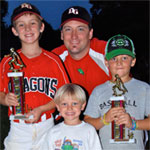Teaching Pitchers Different Pitching Grips
What Pitches Should I Teach My Players?
Every player wants to learn a variety of pitches and every coach loves calling for that out pitch with two strikes. Interesting things can be done by just working on a variety of pitching grips. Changeups and the different variations of fastballs are really just regular mechanics with unique pitching grips. The question is when do you start working on different types of pitches?
Proper Pitching Mechanics and Safety
First, a note about safety. We are not advising teaching young pitchers pitches their arms are not ready for. We strongly recommend that a player has proper pitching mechanics before you begin working on any additional variables that may cause improper mechanics and risk injury.
The Changeup
The first pitch I would teach after a player masters the four-seam fastball is a changeup. Unless a pitcher has above average velocity, the challenge with the changeup is not making it a pitch that's easier to handle than the pitcher's fastball. This will require precise location of the pitch.
I will talk more about changeups in my next post but there are many varieties of changeup that very from easy to difficult so you will be able to find one for any pitcher regardless of skill level or hand size. Some of the more popular changeups are the three-finger changeup, the C changeup and the circle changeup.
Two Seam Fastball
Another option is teaching a two seam fastball. The two seam fastball will sink or cut depending on which side of the ball you place your fingers. If thrown with the same arm motion as a four-seam fastball there should not be additional stress put on the pitcher's arm. Other fastball type pitches like the split-finger fast balls (splitters) and forkballs can put more strain on the arm and should be taught by a professional pitching instructor if possible.
Breaking Balls
After these pitches, you will eventually want to work on a breaking ball with your pitcher. Common breaking balls are the curveball, the slider, the slurve and the screwball. Again, this is best done once the players arm is fully developed and their mechanics are nearly flawless. I highly recommend getting a professional pitching instructor to work with your player when he's ready to throw a breaking ball. Improper form will put an enormous amount of stress on the pitcher's arm and significantly increase the risk of injury.
Have Fun With It
Working on pitching grips with players is one of my favorite things to do in baseball. It's something that can be introduced casually while playing catch and then further developed once players start to get the feel for it. Adding a second pitch let's a pitcher start to think baseball strategy and with their new found option for deceiving the hitter. And nothing gets the players more excited than building up an arsenal of pitches.

